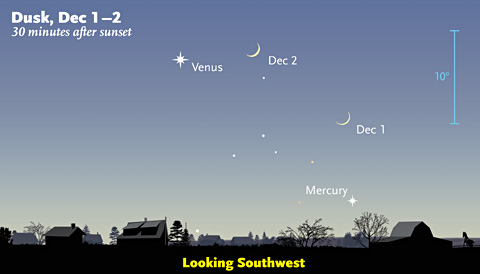Astronomy - Tour December’s Sky: Orion Arising
Download our monthly astronomy podcast to track down Mercury in the evening sky. Then swing around to the east, to behold Orion, the mighty Hunter, climbing into the sky.

Venus is easy to spot throughout December. Mercury starts off challenging but becomes easier to spot by midmonth.
Sky & Telescope diagram
Sky & Telescope diagram
On December 21st, at 5:44 a.m. Eastern Standard Time, we reach a celestial turnaround point: the solstice. This Latin word means “Sun stands still.” At that moment the Sun has traveled farthest south in the sky, and it reverses direction to gradually move northward among the stars. This date marks the astronomical beginning of summer in the Southern Hemisphere and of winter in the north.

The Moon glides through Taurus this month. On the night of December 12th, one day before full, it passes in front of the star Aldebaran.
Sky & Telescope diagram
Sky & Telescope diagram
Venus is dominating the west as it gets dark and now sets about 3 hours after the Sun. To its upper left, by a little less than twice the width of your outstretched fist (in early December), is the red planet Mars. The two planets draw closer together during the month.
Meanwhile, the majestic stars of Orion veritably leap up over the eastern horizon around 7 p.m. at the beginning of the month. But you’ll see it soon after sunset by month’s end.
Look for the Hunter’s distinctive belt of three stars, oriented as a vertical row as the constellation climbs into the sky. The belt is flanked by ruddy Betelgeuse to its left and icy-white Rigel to its right. Higher up are Aldebaran, the eye of Taurus, the Bull, and above that the Pleiades star cluster.
For more skywatching tips for December, listen to or download our monthly astronomy podcast below.
Podcast: Play in new window | Download
No comments:
Post a Comment